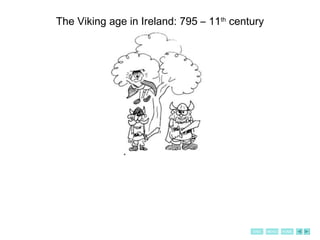
Viking powerpoint 190313
- 1. END HOMEMENU The Viking age in Ireland: 795 – 11th century From raiding to settlement
- 2. END HOMEMENU The first Viking attack – monastery on Rathlin Island, 795 Ireland 'became filled with immense floods, and countless sea-vomiting of ships, and boats, and fleets'. Click here for simple timeline University brooch
- 3. END HOMEMENU At first the Vikings raided Irish monasteries and returned to Scandinavia with their treasure. The Vikings attacked the monasteries because they were rich in land, stock and provisions. They also took valuable objects but this was not their primary concern. The Vikings inspired fear. One monk wrote: Since tonight the wind is high, The sea’s white mane a fury, I need not fear the hordes of Hell Coursing the Irish Channel. Viking Raids
- 4. END HOMEMENU Link Ireland – an easy target ? Rich monasteries When they were first set up around 500 AD, Irish monasteries were not worth attacking. Later many grew in size, forming small monastic towns, with agricultural dependants, craftsmen, and traders, forming. They also became very rich and produced beautiful and valuable metalwork.
- 5. END HOMEMENU Artist’s impression of an early Irish monastery Artist’s impression of an Irish monastery in Viking times
- 6. END HOMEMENU Leading Irish monasteries aerial views Clonmacnoise, Co. Offaly Glendalough, Co. Wicklow
- 7. END HOMEMENU Artist’s impression of Glendalough
- 8. END HOMEMENU Were you listening….. • What were early monasteries like? • Name some monasteries. • Why did the Vikings attack monasteries?
- 9. END HOMEMENU The round tower Round towers in monasteries were first and foremost bell houses. They were five stories high. Each storey had a wooden floor, reached by a ladder The top storey had four to six windows, from which a small hand-bell would have been rung. Round towers were also used for defence against attack – a refuge for people and possessions. Their chimney-like form meant they were not ideal for such defence – fire could easily spread. In 1097, for example, the tower of Monasterboice was burned ‘with its books and many treasures’. Templeoran monastic site, Co. Westmeath
- 10. END HOMEMENU Treasures Moylough Belt Shrine Ardagh chalice O’Donnell Battle Book
- 11. END HOMEMENU Book of Kells
- 12. END HOMEMENU
- 13. END HOMEMENU Were you listening… • Tell me about round towers. • Name some famous treasures.
- 14. END HOMEMENU Pagans versus Christians The Vikings were pagans. The Irish were Christians. Christians worshipped one God. The Vikings believed in several gods. The most powerful was Odin. Others included Thor, the God of Thunder, and Freya, goddess of love. Christians had a symbolic sacrifice in the mass. Vikings made sacrifices of animals and people. They believed that this kept their gods happy. Thor Odin Freya
- 15. END HOMEMENU Viking gods - Thor In Norse mythology, Thor was the god of thunder. He produces thunder with his hammer, called Mjolnir, which means ‘The Destroyer’. This hammer was made by dwarfs, and would magically return to Thor's hand whenever he needed it. Thor is depicted as a tall, muscular man with red hair and a beard. His magic belt could double his incredible strength, while his iron gloves protected his hands. Click here to return to original page
- 16. END HOMEMENU Viking gods - Freya In Norse mythology, Freya is a goddess of love and the most beautiful and propitious of the goddesses. She is the patron goddess of. She loves music, spring and flowers, and is particularly fond of the elves (fairies). Freya lives in the beautiful palace Folkvang (‘field of folk’), a place where love songs are always played. Click here to return to original page
- 17. END HOMEMENU Were you listening… • What religion were the Vikings? • Name some of the gods the Vikings believed in. • Tell me about Thor. • Tell me about Freya.